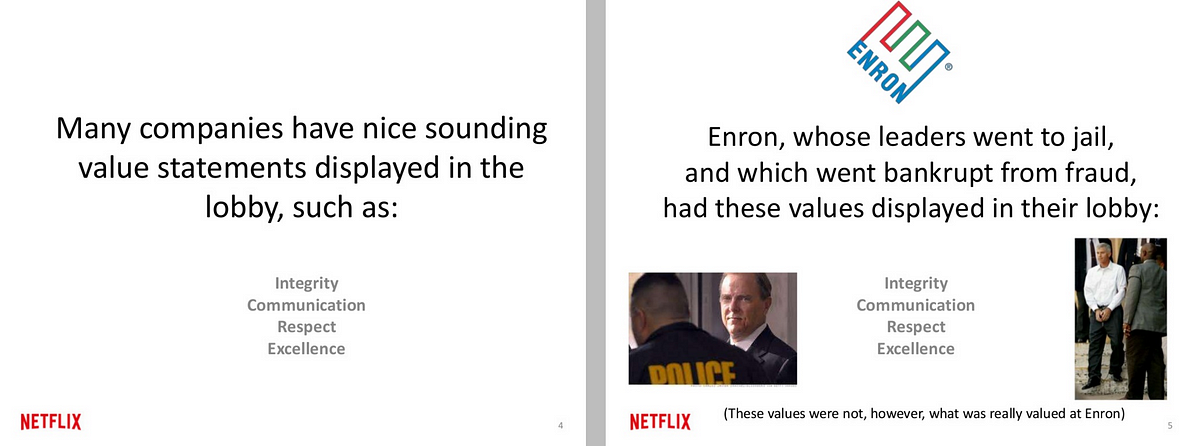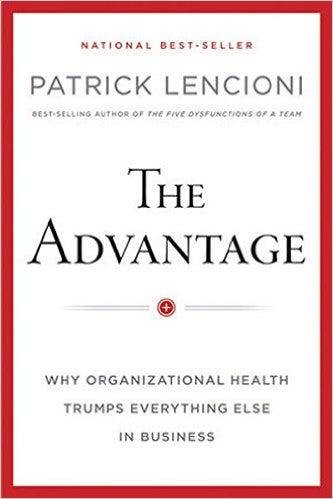Core behavioral values, whether you want them or not
By: Tim Cynova // Published: January 31, 2017
Here’s the good news. Your company has core behavioral values! Here’s the bad news. They might not be ones you want, ones you’re particular proud of, or ones you would print on a t-shirt even to wear on laundry day. Every organization — and every individual, for that matter — has core behavioral values. Values that define and drive the way we act, inform our work and decision-making, and signal to the world in a calling card of sorts, this is what’s important to us.

I love these two slides from Reed Hastings’s now legendary Netflix Culture slide deck. In the first, we find a list of upstanding corporate values: Integrity, Communication, Respect, Excellence. In the second, we find out that those values belonged to Enron, a company whose leaders went to jail for fraud, and — along with the dissolution of its accounting firm Arthur Andersen — went bankrupt. And this is an example of a company that took the time to articulate its values. Why even try?
Well, there are many more companies that state and live by their core behavioral values than go bankrupt and send people to prison. In the absence of core behavioral values, what are you going to use to help inform the way you act, the traits you look for in new hires, guide the decisions your organization makes, or even how your organization goes about making decisions in the first place? How does everyone in the organization know that the decisions they’re making are guided by the same principles? Is everyone just going by their gut? That’s like blowing up a balloon and letting it go before tying it off. Core behavioral values are a little bit like your operating system. They help you figure out what programs will run and how.
Note that “behavioral values” are different from the traditional “values” that many organizations define. When a company writes a values statement they’re usually looking externally and thinking about the change they want to make in the world. Behavioral values are internal and about the how — how you behave every day as you pursue your mission and run your business.
Why define your core behavioral values? You have some whether or not you articulate them. Take the time to make sure that the ones you project are the ones people perceive. People are attracted to, and repelled from, organizations because of their core behavioral values. Think Zappos versus Verizon. Or Apple versus BP. Does an organization’s values align with mine? Yes? Great! No? Next.
If right about now you’re thinking, uh oh, what are our core behavioral values? Again, here’s the good news, if your organization has been around for a while you already have some. (If you’re just starting out, congrats, it’s far easier to articulate behavioral values on day 1 than on day 1,000.) For those of us who are building the plane while flying it though, we merely need to carve away the marble to set the angel(s) free. Then, if you wish, you can go about trying to change the angels.
If you’re daunted by the thought of having to figure out how to articulate your organization’s core behavioral values from scratch, don’t fret, I can point you in a helpful direction. One of the most straight-forward tools I’ve found to help articulate core behavioral values is found in Patrick Lencioni’s The Advantage. (You might know Lencioni from his business parables like TheFive Dysfunctions of a Team, Death by Meeting, and Silos, Politics & Turf Wars.) The Advantage rolls the lessons from each of his parables into one convenient How To manual. We used his framework at Fractured Atlas to help us articulate our core behavioral values, and you can too.

I encourage you to purchase a copy of The Advantage for yourself. (I make no money off of the sale, that I know of.) In the meantime, while you’re waiting for it to arrive or download, here’s the gist of the core behavioral value process Lencioni outlines.
There are essentially three steps:
1. Think of your stellar staff members — past and present — the ones who really make things happen and exemplify the best in your organization. What is it about them, their traits, their behaviors, the way they approach their work that sets them apart? Write those things down.
2. Flip the exercise and think about people who struggle(d) at your organization, or just don’t quite have what it takes to be successful with you. What is it about them, their traits, their behaviors, the way they approach their work that sets them apart? Write those traits down.
3. Now start carving the marble. Sift through the piles. Look for similarities and themes. Then start honing in on the handful of ones that really epitomize your organization.
During the marble carving phase there are a few pitfalls to be aware of. These pitfalls include what Lencioni calls “aspirational,” “accidental”, and “permission-to-play” values. These are the detours that distract you from making progress along the way to solidifying your 2–4 core behavioral values.
Aspirational
I think all four of Enron’s values can be considered aspirational, or wishful thinking, values. That is, unless you give them Excellence for being really great at committing fraud. Aspirational values are the things we want for our organization, hope we’re doing, but might not (yet) be there. At a later date you might decide to adopt one or more, but that takes intent, persistence, and time before it can hop over the rope into the core section.
Permission-to-play
On the other hand, permission-to-play values are the baseline, or minimum, values that your organization needs to possess to operate. Look at Enron’s example again — Integrity, Communication, Respect, Communication — I bet thousands of other companies around the world articulate those same things as their values. Wah-wah, what a letdown. How generic. There’s nothing in that list that’s unique, or special, or that differentiates one company with those from another. In Enron’s case, that list merely masked the actual core behavioral values that led to its demise. Want to use permission-to-play values? You might as well just adopt the Golden Rule and call it a day. To help you from selecting permission-to-play values, ask yourself if your organization can credibly claim to be 99% better at that thing than your competitors. If so, then maybe. If not, shelve it and move on.
Accidental
And lastly, we arrive at accidental values. These are what we’ve likely developed unintentionally — we value eating donuts, wearing plaid, and complaining about how much work we have to do — unless we’ve taking the time to articulate and adhere to our core behavioral values. Accidental values follow the, “How you spend your time is how you spend your life,” axiom. Be care, if you don’t check, you might be surprised to find out what’s occupying the place instead.
Take time this year to articulate the values that matter most to you and your organization. Your future might just depend on it [insert ominous sound effect].
Tim Cynova is a leader, HR consultant, and educator dedicated to co-creating anti-racist and anti-oppressive workplaces through using human-centered organizational design. He is a certified Senior Professional in HR, trained mediator, principal at Work. Shouldn’t. Suck., on faculty at New York’s The New School and Canada’s Banff Centre for Arts and Creativity, and for the past twelve years served as COO and then Co-CEO of the largest association of artists, creatives, and makers in the U.S.
